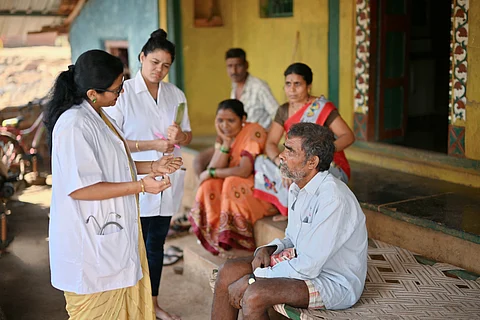

The Economic Survey 2024-25, tabled in Parliament by Union Finance Minister Nirmala Sitharaman on January 31, 2025, has painted a rosy picture of India’s health spending. Health expenditure rose to Rs 6.1 lakh crore in 2024-2025 from Rs 3.2 lakh crore in 2020-2021, rising at a compound annual growth rate of 18 per cent.
India spent a total of Rs 9.04 lakh crore on health in the financial year 2022, accounting for 3.8 per cent of the gross domestic product (GDP) or Rs 6,602 per person at current prices, the report said. The spending per person (adjusted for inflation) has been steadily increasing since 2019, the survey stated.
“An increase in the share of capital expenditure is a positive sign as it will lead to broader and better health infrastructure,” it said.
Out of this total expense of Rs 9.04 lakh crore, Rs 7.89 lakh crore (87.3 per cent) went towards ongoing healthcare expenses, while Rs 1.14 lakh crore (12.7 per cent) was spent on building and improving health infrastructure. The share of money spent on infrastructure has doubled since 2016, growing from 6.3 per cent to 12.7 per cent — a good sign for better health facilities in the future, the report indicated.
Government spending on health has been rising, reducing the financial burden on families, the survey said. Between 2015 and 2022, the share of government health spending in total health expenditure increased to 48 per cent from 29 per cent — which the report attributed to Ayushman Bharat-Pradhan Mantri Jan Arogya Yojana (AB-PMJAY).
At the same time, out-of-pocket expenses for healthcare (what people pay directly from their own money) dropped to 39.4 per cent in 2021-22 from 62.6 per cent in 2014-15, the survey said.
“AB-PMJAY has played a decisive role in the significant reductions observed in out-of-pocket expenses through an increase in social security and primary health expenditure, with over Rs 1.25 lakh crore in savings recorded,” the survey noted. As of January 15, 2025, more than 4 million senior citizens have been enrolled in the scheme.
Other initiatives, such as the free dialysis scheme, have benefited roughly 2.5 million people, the survey said.
Government health insurance schemes covered 5.87 per cent of total healthcare funding, the report stated. Social insurance schemes like Employees’ State Insurance Corporation, Central Government Health Scheme and Ex-Servicemen Contributory Health Scheme made up 3.24 per cent, while voluntary schemes like AB PM-JAY, Rashtriya Swasthya Bima Yojana, and state-specific insurance schemes accounted for 2.63 per cent.
In 2024, full immunisation coverage reached 93.5 per cent across the country under the Universal Immunisation Programme, the survey said. Currently, the UIP provides 11 vaccines free of charge, protecting against 12 preventable diseases. A child is considered fully immunised by their first birthday if they receive the Bacille Calmette Guerin vaccine, three doses of the oral polio vaccine, three doses of the pentavalent vaccine and one dose of the measles rubella vaccine.
The Jan Aushadhi scheme, which provides low-cost medicines, has seen significant growth, with record sales expected in 2024 and over 14,000 centres now open across India, the report added.